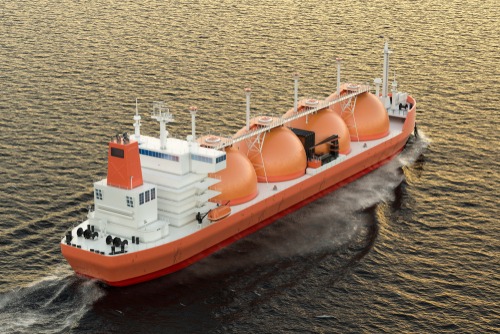Global Gas Crunch Pushes Liquid Natural Gas Shipping Rates to Record Highs
Demand for natural gas has been climbing throughout the year as European countries attempt to stock up ahead of winter, and as of early October it costs a record $400,000/day to lease a transoceanic liquified natural gas (LNG) carrier

Global energy markets have been thrown into disarray due to the war in Eastern Europe, with volatility in the sector spiking dramatically in 2022.
In the current environment, one of the biggest beneficiaries has been the companies that transport energy commodities across the world’s oceans.
As of October 2022, it now costs nearly $400,000/day to lease a liquified natural gas (LNG) carrier—the vessels outfitted to store and transport natural gas from one corner of the globe to another.
Demand for natural gas has been climbing throughout the year as European countries attempt to stock up ahead of winter. And as a result of the war in Eastern Europe, the region has been forced to source natural gas from places like Algeria, Norway and the United States.
The Russian Federation has been a key supplier of natural gas in the European region for many years, but throttled back energy exports to Europe in 2022 as a result of political differences stemming from the Russo-Ukrainian war.
In order to be prepped for transport, natural gas must first be liquified and then pumped into specialized LNG carriers. Liquified natural gas is roughly 600 times denser than naturally occurring gas, but it also takes up far less volume.
Once an LNG carrier reaches its destination, the liquid natural gas must then be reconverted into gas. For this reason, LNG infrastructure also plays a key role in the global supply network and represents one of the biggest bottlenecks in the current environment.
At present, countries like Germany and the Netherlands are building new LNG import/export facilities, but the existing infrastructure in Europe wasn’t built to handle the type of volume necessary to support such a large chunk of the region’s import requirements. Traditionally, Europe has imported the bulk of its natural gas requirements via transcontinental pipelines.
As a result of the new market paradigm, natural gas prices have traded at multi-decade highs in 2022, which has also catalyzed a sharp spike in LNG shipping rates. With winter approaching, carriers are now being commissioned to deliver their payloads during the height of winter, when stocks of this essential resource are expected to be partially depleted.
Due to constrained capacity in the sector, some industry analysts are now forecasting that daily LNG shipping rates could climb as high as $500,000/day at some point in the coming weeks, and potentially much higher in winter.
Energy companies are willing to pay the exorbitant transport costs because the profits from a shipload of LNG can be in the tens of millions of dollars. Currently, it’s estimated that the global LNG fleet amounts to roughly 700 carriers.
Natural gas prices have been up as much as 160% in 2022 due to supply disruptions linked to the war in Ukraine. But in the last several months, prices have tumbled due to a slowdown in the global economy, which could ultimately cramp demand.
In the coming years, forecasts suggest that global demand for natural gas will only grow. Some projections suggest that global consumption of natural gas could increase to 700 million tons by 2040—a 90% increase from 2021 levels.
Those forecasts suggest that the global LNG network—of carriers and import/export infrastructure—will need to expand rapidly to keep pace with the market.
Two companies with concentrated exposure to the transoceanic shipment of natural gas are Dynagas LNG Partners (DLNG) and Golar LNG Limited (GLNG). To track and trade the natural gas sector, readers can add the following symbols to their watchlists:
- Antero Resources Corporation (AR)
- Cabot Corporation (CBT)
- Cheniere Energy (LNG)
- Chesapeake Energy (CHK)
- Chevron Corporation (CVX)
- Enbridge (ENB)
- EQT Corporation (EQT)
- Kinder Morgan (KMI)
- ProShares Ultra Bloomberg Natural Gas (BOIL)
- ProShares UltraShort Bloomberg Natural Gas (KOLD)
- Range Resources Corporation (RRC)
- Southwestern Energy (SWN)
- United States 12 Month Natural Gas Fund LP (UNL)
- United States Natural Gas Fund LP (UNG)
To learn more about trading the 2022 natural gas market, watch this installment of Splash Into Futures.
For daily updates on everything moving the markets—including in the solar sector—check out TASTYTRADE LIVE—weekdays from 7 a.m. to 4 p.m. CDT.
Sage Anderson is a pseudonym. He’s an experienced trader of equity derivatives and has managed volatility-based portfolios as a former prop trading firm employee. He’s not an employee of Luckbox, tastytrade or any affiliated companies. Readers can direct questions about this blog or other trading-related subjects, to support@luckboxmagazine.com.



















